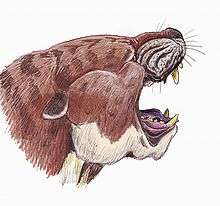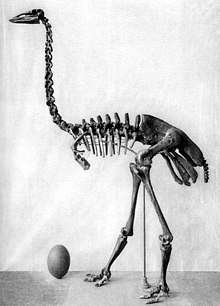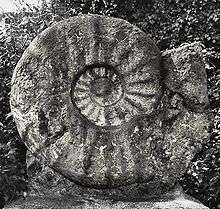Largest prehistoric animals
The largest prehistoric organisms include both vertebrate and invertebrate species. Many of them are described below, along with their typical range of size (for the general dates of extinction, see the link to each). Many species mentioned might not actually be the largest representative of their clade due to the incompleteness of the fossil record and many of the sizes given are merely estimates since no complete specimen have been found. Their body mass, especially, is mostly conjecture because soft tissue was rarely fossilized. Generally the size of extinct species was subject to energetic[1] and biomechanical constraints.[2]
Vertebrates
Mammals (Mammalia)
Monotremes (Monotremata)
- The largest-known monotreme (egg-laying mammal) ever was the extinct long-beaked echidna species known as Zaglossus hacketti, known from a couple of bones found in Western Australia. It was the size of a sheep, weighing probably up to 30 kg (66 lb).[3]
Marsupials (Marsupialia)
- The largest-known marsupial is the extinct Diprotodon, about 3 m (9.8 ft) long, standing 2 m (6 ft 7 in) tall and weighing up to 2,786 kg (6,142 lb).[4] Fellow Vombatiform Palorchestes azael was similar in length being around 2.5 m (8.2 ft), with body mass estimates indicating it could exceed 1,000 kg (2,200 lb).[5]
- The largest-known carnivorous marsupial was Thylacoleo carnifex. Measurements taken from a number of specimens show they averaged 101 to 164 kg (223 to 362 lb) in weight.[6] Thylacosmilus, Borhyaena, Proborhyaenidae were also comparable.
- The largest-known kangaroo was Procoptodon, which could grow to 3 m (10 ft) and weigh 230 kg (510 lb).[7] Some species from the genus Sthenurus were similar in size as well.
Even-toed ungulates (Artiodactyla)
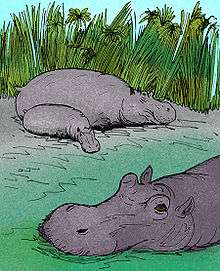
- The largest-known artiodactyl was Hippopotamus gorgops with a length of 4.3 m (14 ft) and a height of 2.1 m (6 ft 11 in). Bison latifrons reached a shoulder height of 2.5 m (8 ft 2 in), and had horns that spanned over 2 m (6 ft 7 in). Pelorovis also reached 2 t (2.0 long tons; 2.2 short tons) in weight. Aside from local populations and subspecies of extant species, such as the Gaur population in Sri Lanka, European Bison in British Isles, Caucasian wisent and Carpathian wisent, the largest, modern extinct bovid is Aurochs (Bos primigenius) with an average height at the shoulders of 155–180 cm (61–71 in) in bulls and 135–155 cm (53–61 in) in cows, while aurochs populations in Hungary had bulls reaching 155–160 cm (61–63 in).[8] The Kouprey, reaching 1.9 m (6 ft 3 in) is also considered to be possibly extinct.
- The largest-known camel that ever lived was the Syrian camel. It was 3 m (9.8 ft) at the shoulder and 4.0 m (13 ft) tall. Titanotylopus from North America, possibly reached 2,485.6 kg (5,480 lb) and a shoulder height of over 3.4 m (11 ft).[9][10]
- The largest known ruminant , aside from modern giraffe is Sivatherium with body weight at 1,250 kg (2,760 lb).
- Daeodon was the largest-known entelodont that ever lived, at 3.7 m (12 ft) long and 2.1 m (7 ft) at the shoulder.
- The largest-known wild suid to ever exist was Kubanochoerus gigas, having measured up to 550 kg (1,210 lb) and stood more than 1.3 m (4 ft 3 in) tall at the shoulder.[11]
- The extinct Irish elk (Megaloceros giganteus) and the stag-moose (Cervalces scotti) were of similar size to the Alaskan moose. However, the Irish elk could have antlers spanning up to 4.3 m (14 ft) across, about twice the maximum span for a moose's antlers.[12] Cervalces latifrons was twice as heavy as the Irish elk but its antlers were smaller.[13]
Cetaceans (Cetacea)
- Certain rorquals from the Pliocene possibly rivaled the size of modern blue whales.[14]
- The largest prehistoric sperm whale, or toothed whale was Livyatan melvillei weighing in at about 57 tonnes (63 short tons).
Odd-toed ungulates (Perissodactyla)
- The largest-known perissodactyl, and the second largest land mammal (see Palaeoloxodon namadicus) of all time was the hornless rhino Paraceratherium. The largest individual known was estimated at 4.8 m (15.7 ft) tall at the shoulders, 7.4 m (24.3 ft) in length from nose to rump, and 17 t (18.7 short tons) in weight.[15][16]
- Some prehistoric horned rhinos also grew to large sizes. The giant woolly rhino Elasmotherium reached 6 m (20 ft) long and 2 m (6 ft 7 in) high.
- The largest prehistoric horse was Equus giganteus of North America. It was estimated to grow to more than 1,250 kg (1.38 short tons) and 2 m (6 ft 7 in) at the shoulders.[17]
- The giant tapir Tapirus augustus was the largest tapir ever, at about 1,100 lbs (500 kg), 2.1 metres (6.9 ft) long and 0.9 metres (3.0 ft) tall at the shoulders to 3.5 metres (11 ft) long
Carnivores (Carnivora)
- The largest terrestrial known carnivoran and the largest-known bear as well as the largest-known mammalian land-predator of all time was Arctotherium angustidens or the South American short-faced bears. A humerus of A. angustidens from Buenos Aires indicate that the large males could have weighed 1,588–1,749 kg (3,501–3,856 lb) and standing at least 3.4 m (11 ft) tall on the hind-limbs.[18][19]
- The largest viverrid known to have existed is Viverra leakeyi, which was around the size of a wolf or small leopard at 41 kg (90 lb).[20]
- The heaviest known felids are the Ngangdong tiger (Panthera tigris soloensis), with the largest specimen weighing up to 470 kg (1,040 lb),[21][22] the American lion (Panthera leo atrox or P. atrox), weighing up to 420 kg (930 lb)[23][24] and saber-toothed cats Amphimachairodus kabir and Smilodon populator, with the males possibly reaching 350–490 kg (770–1,080 lb) and 220–400 kg (490–880 lb) respectively.[25][26]
- The largest known wolf species is the dire wolf (Canis dirus) 1.5 m (4 ft 11 in) in length and weighed between 50 and 110 kg (110 and 243 lb).[25][27] The largest canid of all time was Epicyon haydeni, which stood 0.94 m (37 in) tall at the shoulder. The largest bear-dog was a species of Pseudocyon weighing around 773 kg (1,704 lb), representing a very large individual.[28]
- The largest-known mustelid to ever exist was likely the giant otter, Enhydriodon. It exceeded 3 m (9.8 ft) in length, and would have weighed in at around 200 kg (440 lb), much larger than any other known mustelid, living or extinct.[29][30] There were other giant otters, like Siamogale, at around 50 kg (110 lb)[31] and Megalenhydris, which was larger than a modern-day giant river otter.[32] Another large-bodied mustelid was the superficially cat-like Ekorus from Africa, about the size of a leopard and filling a similar ecological niche before big cats came to the continent. Megalictis was thought to be around the size of a black bear according to old estimates. Newer estimates, however, significantly downgrade its size, although, at a maximum weight more than twice that of a wolverine, it is larger than most (if not all) living mustelids.
- The largest known fossil hyena is Pachycrocuta, estimated at 190 kg (420 lb).[25] The closely related percrocutid feliform, Dinocrocuta, was even bigger, 300 kg (660 lb).[33]
Armadillos, glyptodonts and pampatheres (Cingulata)
The largest cingulate known is Doedicurus, at 3.8 m (12 ft) long and reaching a mass of approximately 1,910 to 2,370 kg (2.11 to 2.61 short tons) Glyptodon easily topped 3.3 m (11 ft) and 2 t (2.2 short tons).
Hedgehogs, gymnures, shrews, and moles (Erinaceomorpha and Soricomorpha)
The largest-known animal of the Erinaceomorpha and Soricomorpha groups was Deinogalerix,[34] measuring up to 60 cm (24 in) in total length, with a skull up to 20 cm (7.9 in) long.
Rabbits, hares, and pikas (Lagomorpha)
The largest-known prehistoric lagomorph is Minorcan giant lagomorph (Nuralagus rex) at 23 kg (51 lb).
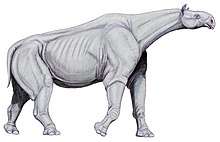
Cimolestids (Cimolesta)
The largest-known cimolestid is Coryphodon, 1 m (3 ft 3 in) high at the shoulder and 2.25 m (7 ft 5 in) long.
Anteaters and sloths (Pilosa)
- The largest-known pilosan ever was Megatherium, a ground sloth with an estimated average weight of 3.8 t (4.2 short tons)[35] and a height of 6 m (20 ft)[35] which is close to the size of the African bush elephant. Several other sloths grew to large sizes as well, such as Eremotherium, but none as large as Megatherium.
Primates (Primates)
- The largest-known primate of all time was Gigantopithecus blackii, standing 3 m (9.8 ft) tall and weighing 540 kg (1,200 lb).[36][37]
- The largest-known old world monkey, the prehistoric baboon, male of Dinopithecus weighing averagely 46 kg (101 lb) and up to 57 kg(125 lb) [38], It exceeds modern largest baboon, Chacma baboon's maximum weight record. Heaviest one is Theropithecus oswaldi, It weighed 72 kg (158 lb).[39]
- The largest-known new world monkey was Protopithecus, weighing up to 23 kg (50 lb).
- Some prehistoric prosimians grew to huge sizes as well. Archaeoindris was a 1.5-metre-long (4.9 ft) lemur that lived in Madagascar and weighed 200 kg (440 lb), as large as a silverback gorilla. Megaladapis is another large extinct lemur at 1.3 to 1.5 m (4 ft 3 in to 4 ft 11 in) in length.
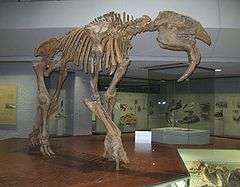
Elephants, mammoths, and mastodons (Proboscidea)
- The largest-known land mammal ever was a proboscidean called Palaeoloxodon namadicus which weighed about 22 t (24.3 short tons), and was about 5.2 m (17.1 ft) tall at the shoulder.[15] The largest individuals of the steppe mammoth of Eurasia (Mammuthus trogontherii) estimated to reach 4.5 m (14.8 ft) at the shoulders and 14.3 t (15.8 short tons) in weight.[15][40]
- Some other enormous proboscideans include the southern mammoth (Mammuthus meridionalis), the Columbian mammoth (Mammuthus columbi), and Deinotherium.
Rodents (Rodentia)
- Josephoartigasia monesi was the largest-known rodent of all time, approximately 3 m (9.8 ft) long and 1.5 m (4 ft 11 in) tall and weighing an estimated 1 t (1.1 short tons).[41]
- Before the discovery of Josephoartigasia monesi, another giant rodent was known, Phoberomys insolita, but it was known from only a few fragments, so its real size is unknown. A slightly smaller relative, Phoberomys pattersoni, was found, which was 3 m (9.8 ft) long and weighed 320 kg (700 lb).
- The largest beaver was the giant beaver of North America. It grew over 2.4 m (8 ft) in length and weighed roughly 60 to 100 kg (130 to 220 lb), also making it one of the largest rodents to ever exist.
Astrapotherians (Astrapotheria)
Some of the largest-known astrapotherians weighed about 3–4 t (3.3–4.4 short tons), including the genus Granastrapotherium[42] and some species of Parastrapotherium (P. martiale).[43] The skeleton remains suggests that the species Hilarcotherium miyou was even larger, with a weight of 6.456 t (7.117 short tons).[44]
Arsinoitheres (Arsinoitheriidae)
The largest-known arsinoithere was Arsinoitherium. When alive, it would have been 1.8 m (5 ft 11 in) tall at the shoulders, and 3 m (9.8 ft) long.
Condylarths (Condylarthra)
The largest-known condylarth is Phenacodus. It was 1.5 m (4 ft 11 in) long and weighted up to 56 kg (123 lb).
Dinoceratans (Dinocerata)
The largest-known dinoceratan was Uintatherium. It was about the size of a rhinoceros. Despite its large size, it had a brain only about as large as an orange.
Desmostylians (Desmostylia)
The largest-known desmostylian was a species comparable in size to the Steller's Sea Cow.[45]
Litopterns (Litopterna)
The largest-known litoptern was Macrauchenia, which had three hoofs per foot. It was a relatively large animal, with a body length of around 3 m (9.8 ft).[46]
Notoungulates (Notoungulata)
The largest notoungulate known of complete remains is Toxodon. It was about 2.7 m (8 ft 10 in) in body length, and about 1.5 m (4 ft 11 in) high at the shoulder and resembled a heavy rhinoceros. Although is not complete, the preserved fossils suggests that Mixotoxodon were the most massive member of the group, with a weight about 3.8 t (4.2 short tons).[47]
Oxyaenids (Oxyaenidae)
The largest-known oxyaenid was Sarkastodon weighing in at 800 kg (1,800 lb).[48]
Hyaenodontids (Hyaenodontidae)
The largest hyaenodontid was Simbakubwa at 1,500 kg (3,300 lbs).
Mesonychids (Mesonychia)
The largest mesonychid was Mongolonyx robustus. This predator would have been 1.3–1.4 m (4 ft 3 in–4 ft 7 in) tall at the shoulders and 2.7–2.8 m (8 ft 10 in–9 ft 2 in) long.
Non-mammal synapsids (Synapsida)
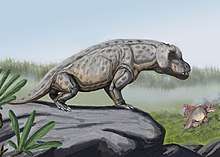
Pelycosaurs
The herbivorous Cotylorhynchus hancocki was the largest of the pelycosaurs and the largest amniote to have lived at the time, with an estimated length and weight of at least 6 m (20 ft) and 500 kg (1,100 lb).[49][50] The biggest carnivorous pelycosaur was Dimetrodon angelensis, which could reach 4.6 m (15 ft) and 250 kg (550 lb). The largest members of the genus Dimetrodon was also the world's first fully terrestrial apex predators.[51]
Therapsids
The plant-eating dicynodont Lisowicia bojani is the largest-known of all non-mammal synapsids, at 4.5 m (15 ft) and 9,000 kg (20,000 lb).[52][53][54] Among the largest carnivorous synapsids was the therapsid Anteosaurus, which was 5–6 m (16–20 ft) long, and weighed 500–600 kg (1,100–1,300 lb).[55][56]
Reptiles (Reptilia)
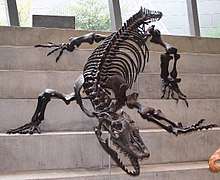
Crocodiles and relatives (Crocodylomorpha)
- The largest-known crocodylomorph is likely Sarcosuchus imperator at 12 m (39 ft) long and weighing 8 t (8.8 short tons).[57]
- Some close contenders in size are Deinosuchus estimated at around 12 m (39 ft),[58] and Purussaurus estimated at 11–13 m (36–43 ft) in length.[59] Another large crocodilian is Rhamphosuchus, estimated at 8–11 m (26–36 ft) in length.[60]
- The largest terrestrial sebecid crocodylomorph is Barinasuchus, from the Miocene of South America, which reached 9 m (30 ft) long.
- The largest-known rauisuchian is Fasolasuchus tenax, which measured an estimated 8–10 metres. It is both the largest rauisuchian known to science, and the largest non-dinosaurian terrestrial predator ever discovered.
Lizards and snakes (Squamata)
- Giant mosasaurs are the largest-known animals within the Squamata. The largest-known mosasaur is likely Mosasaurus hoffmanni, estimated at 17.6 m (58 ft) in length.[61] Another giant mosasaur is Tylosaurus, estimated at 10–14 m (33–46 ft) in length.[62][63] Another large mosasaur is Hainosaurus bernardi (could be synonymous to Tylosaurus). It was once estimated at 17 and 15 m (56 and 49 ft) in length,[64][65] but later estimates put it at around 12.2 m (40 ft).[66]
- The largest-known prehistoric snake is Titanoboa cerrejonensis, estimated at 12.8 m (42 ft) in length and 1,135 kg (2,502 lb) in weight.[67] Another known very large fossil snake is Gigantophis garstini, estimated at around 9.3–10.7 m (31–35 ft) in length.[68][69] A close rival in size to Gigantophis is a fossil snake, Palaeophis colossaeus, which may have been around 9 m (30 ft) in length.[67][70][71]
- The largest-known land lizard is probably Megalania at 7 m (23 ft) in length.[72] However, maximum size of this animal is subject to debate.[73]
Plesiosaurs
Plesiosauroids (Plesiosauroidea)
The longest known plesiosauroid was Styxosaurus at 12 m (39 ft) long. Other elasmosaurs, such as Albertonectes and Thalassomedon, rivaled the aforementioned Styxosaurus in size.
Pliosauroids (Pliosauroidea)
There is much controversy over the largest-known of the Pliosauroidea. Fossil remains of a pliosaur nicknamed as "Predator X" have been discovered and excavated from Norway in 2008. This pliosaur has been estimated at 15 m (49 ft) in length and 45 t (50 short tons) in weight.[74][75] However, in 2002, a team of paleontologists in Mexico discovered the remains of a pliosaur nicknamed as "Monster of Aramberri", which is also estimated at 15 m (49 ft) in length.[76] This species is, however, claimed to be a juvenile and has been attacked by a larger pliosaur.[77] Some media sources claimed that Monster of Aramberri was a Liopleurodon but its species is unconfirmed thus far.[76] Another very large pliosaur was Pliosaurus macromerus, known from a single 2.8-metre-long (9.2 ft) incomplete mandible. It may have reached 18 m (59 ft), assuming the skull was about 17% of the total body length.[78]
Ichthyosaurs (Ichthyosauria)
The largest-known ichthyosaur was Shastasaurus sikanniensis at 21 m (69 ft) in length.[79] In April 2018, paleontologists announced the discovery of a previously unknown ichthyosaur (deemed the lilstock monster) that may have reached lengths of 26 m (85 ft) making it one of the largest animals known, rivaling some blue whales in size. Another, larger ichthyosaur was found in 1850 in Aust, Gloucestershire, being noted in the same paper. Its remains seemed to surpass the measurements of the lilstock monster, but the researchers commented that the remains were too fragmentary for a size estimate to be made..[80]
Turtles and tortoises (Testudines)
- The largest-known turtle ever was Archelon ischyros at 4 m (13 ft) long, 4.9 m (16 ft) wide and 2,200 kg (4,900 lb). The second largest turtle of all time was the fresh-water turtle, Stupendemys, with an estimated total carapace length of more than 3.3 m (11 ft) and weight of up to 1,814–2,268 kg (3,999–5,000 lb).[81] Afterwards, the next largest turtle, and second-largest sea-turtle was Protostega at 3 m (9.8 ft).[82] [83] Carbonemys cofrinii had a shell that measured about 1.72 m (5 ft 8 in) and was estimated to weigh 916 kg (2,019 lb).[84][85][86]
- Two tortoises share the title of largest-known ever tortoise: Meiolania at 2.4 m (8 ft) long and well over 0.91 t (1 short ton), and Colossochelys atlas at 2.4 to 2.7 m (8 to 9 ft)and weighing over 450 kg (0.5 short tons).
Cotylosaurs (Captorhinidae)
The heavy built Moradisaurus grandis, with a length of 2 m (6 ft 7 in),[87] is the largest known captorhinid.[88]
Pareiasaurs (Pareiasauridae)
The largest-known pareiasaur is Scutosaurus, up to 3 m (9.8 ft) in length, with bony armor, and a number of spikes decorating its skull.
Phytosaurs (Phytosauria)
Some of the largest-known phytosaurs include Redondasaurus with a length of 6.4 meters and Smilosuchus with a size of 6.8 meters.
Pterosaurs (Pterosauria)
- The largest-known pterosaur was Quetzalcoatlus northropi, at 127 kg (280 lb) and with a wingspan of 12 m (39 ft). Another close contender is Hatzegopteryx, also with a wingspan of 12 m (39 ft). This estimate is based on a skull 3 m (9.8 ft) long.[89]
- Yet another possible contender for the title is Arambourgiania which also had a 12-metre (39 ft) wingspan.
Non-avian dinosaurs (Dinosauria)

Sauropods (Sauropoda)
- A mega-sauropod, Maraapunisaurus fragillimus, is a contender for the largest-known dinosaur in history. It has been estimated at 58 m (190 ft) in length and 122,400 kg (269,800 lb) in weight.[90] Unfortunately, the fossil remains of this dinosaur have been lost.[90] More recently, it was estimated at 30.3–32 m (99–105 ft) in length.[91]
- Barosaurus lentus may have been the largest sauropod and largest dinosaur yet discovered. Originally thought to reach only 27 m (89 ft), a massive cervical vertebra has been recently attributed to this species, suggesting maximum length of 50 m (160 ft) and masses of up to 100 t (110 short tons).[92]
- Other huge sauropods include Argentinosaurus, Alamosaurus, and Puertasaurus with estimated lengths of 30–33 m (98–108 ft) and weights of 50–80 t (55–88 short tons).[93] Patagotitan was estimated at 37 m (121 ft) in length and 69 t (76 short tons) in mass,[94] and was similar in size to Argentinosaurus and Puertasaurus.[95] Giant sauropods like Supersaurus, Sauroposeidon, and Diplodocus probably rivaled them in length but not weight.[90]
Many large sauropods are still unnamed and may rival the current record holders.
- The "Archbishop", a large brachiosaur that was discovered in 1930. The animal was reported to get a scientific paper published by the end of 2016.[96]
- "Brachiosaurus" nougaredi, is yet another large brachiosaur from Early Cretaceous North Africa. The remains have been lost, but the sacrum drawing remains. They suggest a sacrum of almost 5 ft (2 m) long, making it the largest dinosaur sacrum discovered so far.
- In 2010, the femur of a large sauropod was discovered in France. The femur suggests an animal that grew to immense sizes.[97]
Non-avian theropods (Theropoda)

- The largest theropod as well as the largest terrestrial (or possibly semi-aquatic)[98] predator yet known is Spinosaurus aegyptiacus, with the largest specimen known estimated at 12.6–18 m (41–59 ft) in length and around 7–20.9 t (8–23 short tons) in weight.[99][100]
- Other large theropods were Giganotosaurus carolinii, and Tyrannosaurus rex, whose largest specimens known estimated at 13.2 m (43 ft)[101] and 12.3 m (40 ft)[102] in length, respectively. Some other notable giant theropods (e.g. Carcharodontosaurus, Acrocanthosaurus, and Mapusaurus) may also have rivaled them in size.
Armoured dinosaurs (Thyreophora)
The largest-known thyreophoran was Ankylosaurus at 9 m (30 ft) in length and 6 t (6.6 short tons) in weight.[103][104] Stegosaurus was also 9 m (30 ft) long but around 5 t (5.5 short tons) tonnes in weight.
Ceratopsians (Ceratopsia)
The largest ceratopsian known is Triceratops horridus, along with the closely related Eotriceratops xerinsularis both with estimated lengths of 9 m (30 ft). Ojoceratops and several other ceratopsians rival them in size.[105]
Ornithopods (Ornithopoda)
The very largest-known ornithopods, like Shantungosaurus were as heavy as medium-sized sauropods at up to 23 t (25 short tons),[106][107] and 16.5 m (54 ft) in length.[106]
Birds (Aves)
The largest-known birds of all time might have been the elephant birds of Madagascar. Of almost the same size was the Australian Dromornis stirtoni. Both were about 3 m (9.8 ft) tall. The elephant birds were up to 400 kg (880 lb) and Dromornis stirtoni was up to 500 kg (1,100 lb) in weight. The tallest bird ever was the giant moa at 3.6 m (12 ft) tall.
The largest-known flight-capable bird was Argentavis magnificens with a wingspan of 8.3 m (27 ft), and a body weight of 110 kg (240 lb).
Waterfowl (Anseriformes)
The largest-known waterfowl of all time belonged to the Dromornithidae (e.g. Dromornis stirtoni).[108]
Storks and allies (Ciconiiformes)
The largest-known of Ciconiiformes was Leptoptilos robustus, standing 1.8 m (5 ft 11 in) tall and weighing an estimated 16 kg (35 lb).[109][110]
Hesperornithines (Hesperornithes)
The largest-known of the hesperornithines was Canadaga arctica at 1.5 m (5 ft) long.
Gastornid (Gastornithiformes)
Individuals of Gastornis averaged 1.75 m (5 ft 9 in) in height, with large individuals up to 2 m (6 ft 7 in) tall.
Teratorns (Teratornithidae)
The largest-known teratorn and the largest flying bird ever was Argentavis. The immense bird had a wingspan estimated up to 8.3 m (27 ft) and a weight up to 110 kg (240 lb). It was as high as an adult human when standing.
Phorusrhacids (Phorusrhacidae)
The largest-known-ever gruiform and largest phorusrhacid or "terror bird" (highly predatory, flightless birds of South America) was Brontornis, which was about 175 cm (69 in) tall at the shoulder, could raise its head 2.8 m (9 ft 2 in) above the ground and could have weighed as much as 400 kg (880 lb).[111] The immense phorusrhacid Kelenken stood 3–3.2 m (9.8–10.5 ft) tall with a skull 710 mm (28 in) long (460 mm [18 in] of which was beak), had the largest head of any known bird. The largest North American phorusrhacid is Titanis, which is about 2.5 m (8 ft 2 in) tall, as tall as a forest elephant.
Accipitriforms (Accipitriformes)
The largest-known bird of prey ever was the enormous Haast's eagle (Harpagornis moorei), with a wingspan of 2.6 to 3 m (8 ft 6 in to 9 ft 10 in), relatively short for their size. Total length was probably up to 1.4 m (4 ft 7 in) in female and they weighed about 10 to 15 kg (22 to 33 lb). The largest extinct Titanohierax was a giant hawk about 8 kilograms that lived in the Antilles, where it was among the top predators.
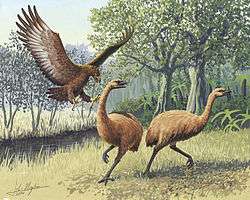
Gamebirds (Galliformes)
The largest-known of the Galliformes was a giant flightless Sylviornis, a bird 1.70 m (5 ft 7 in) long and weighing up to about 30 kg (66 lb).
Songbirds (Passeriformes)
The largest-known songbird is the extinct giant grosbeak (Chloridops regiskongi) at 280 mm (11 in) long.
Cormorants and allies (Pelecaniformes)
The largest-known cormorant was the spectacled cormorant of the North Pacific (Phalacrocorax perspicillatus), which became extinct around 1850, was larger still, averaging around 6.4 kg (14 lb) and 1.15 m (3 ft 9 in).[112]
Bony-toothed birds (Odontopterygiformes)
The largest-known of the Odontopterygiformes—a group which has been variously allied with Procellariiformes, Pelecaniformes and Anseriformes—and the largest flying birds of all time other than Argentavis were the huge Pelagornis, Cyphornis, Dasornis, Gigantornis and Osteodontornis. They had a wingspan of 5.5–6 m (18–20 ft) and stood about 1.2 m (3 ft 11 in) tall. Exact size estimates and judging which one was largest are not yet possible for these birds, as their bones were extremely thin-walled, light and fragile, and thus most are only known from very incomplete remains.
Woodpeckers and allies (Piciformes)
The largest-known woodpecker is the possibly extinct imperial woodpecker (Campephilus imperialis) with a total length of about 560 mm (22 in). The largest woodpecker confirmed to be extant is the great slaty woodpecker (Mulleripicus pulverulentus).
Parrots (Psittaciformes)
The largest-known parrot is the extinct heracles inexpectatus about 1 meter (3.3 feet) long.
Penguins (Sphenisciformes)
The largest-known penguin of all time was Anthropornis nordenskjoeldi of New Zealand and Antarctica. It stood 1.7 m (5 ft 7 in) in height and was 90 kg (200 lb) in weight. Similar in size were the New Zealand giant penguin (Pachydyptes pondeorsus) with a height of 1.4 to 1.6 m (4 ft 7 in to 5 ft 3 in) and weighing possibly around 80 to 100 kg (180 to 220 lb) and over, and Icadyptes salasi at 1.5 m (4 ft 11 in) tall.
Owls (Strigiformes)
The largest-known owl of all time was the Cuban Ornimegalonyx at 1,100 mm (43.3 in) tall probably exceeding 9 kg (20 lb).[113]
Amphibians (Amphibia)

The largest-known amphibian of all time was the 9.1 m (30 ft) long temnospondyli Prionosuchus. Another huge temnospondyli was Koolasuchus at 4.9 m (16 ft) long, but only 0.30 m (1 ft) high.
Frogs (Anura)
The largest-known frog ever was an as yet unnamed species that was about 58–59-centimetre-long (22.8–23.2 in).[114]
Diadectomorpha
The largest-known diacectid, Diadectes, was a heavily built animal, 1.5 to 3 m (4 ft 11 in to 9 ft 10 in) long, with thick vertebrae and ribs.
Anthracosauria
The largest-known anthracosaur was Anthracosaurus, a predator. It could reach up to 3.7 m (12 ft) in length. Eogyrinus commonly reached 4.6 m (15 ft); however, it was more lightly built.[115]
Temnospondyli
The largest-known temnospondyl amphibian is Prionosuchus, which grew to lengths of 9 m (30 ft).[116]
Lobe-finned fish (Sarcopterygii)
The largest-known lobe-finned fish was the 6–7 m (20–23 ft) long Rhizodus.
Ray-finned fish (Actinopterygii)
The largest-known ray-finned fish and largest bony fish of all time was the pachycormid, Leedsichthys problematicus, at around 16.5 m (54 ft) long.[117] Claims of larger individuals persist.
Ichthyodectiformes (Ichthyodectiformes)
The largest-known of ichthyodectiform fish was Xiphactinus, which measured 6.0 m (20 ft) long.
Cartilaginous fish (Chondrichthyes)
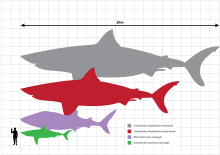
Mackerel sharks (Lamniformes)
An extinct megatoothed shark, C. megalodon is by far the biggest mackerel shark and largest shark known.[118] This giant shark reached a total length of more than 16 m (52 ft).[119][120] C. megalodon may have approached a maximum of 20.3 m (67 ft) in total length and 103 t (114 short tons) in mass.[121]
Symmoriid (Symmoriida)
The largest-known symmoriid was Stethacanthus at 2 m (6 ft 7 in) long.
Eugenedont (Eugeneodontida)
The largest-known eugenedont is an as-yet unnamed species of Helicoprion discovered in Idaho. The specimens suggest an animal that possibly exceeded 12 m (39 ft) in length.[122]
Another fairly large eugenedont is Parahelicoprion. The specimens suggest an animal that grew to the same size (12 m [39 ft]), but was much more slender and overall less heavy.[123]
Hybodontiform (Hybodontiformes)
The largest-known hydontiformid is Ptychodus, which was about 9.8 m (32 ft) long.
Placoderms (Placodermi)
The largest-known placoderm was the 6 m (20 ft) long Dunkleosteus. It is estimated to have weighed around 3.6 t (4.0 short tons). Its relative, Titanichthys, may have rivaled it in size.
Arthropods (Arthropoda)
Radiodont (Radiodonta)
The largest-known is Aegirocassis at least 2.1 m (7 ft) long.[124]
Eurypterids (Eurypterida)
The largest-known in this group was Jaekelopterus rhenaniae at 2.5 m (8 ft 2 in) in length. A close contender was Pterygotus at 2.3 m (7 ft 7 in) in length.
Arachnids (Arachnida)
There are two contenders for largest-known ever arachnid: Pulmonoscorpius kirktonensis and Brontoscorpio anglicus. Pulmonoscorpius was 70 cm (28 in) Brontoscorpio was 90 cm (35 in). The biggest difference is that Brontoscorpio was aquatic, and Pulmonoscorpius was terrestrial. Brontoscorpio is not to be confused with various Eurypterids: it was a true scorpion with a venomous stinger.
Myriapoda
The largest-known myriapod by far was the giant Arthropleura. Measuring 2.5 m (8 ft 2 in) and 45 cm (18 in) wide, it was the largest-known terrestrial arthropod of all time. Like its modern-day relatives, Arthropleura would have likely sprayed hydrogen cyanide at potential predators, although its sheer size and tough exoskeleton protected it from attack.
Trilobitomorpha
Trilobites (Trilobita)
Some of these extinct marine arthropods exceeded 60 cm (24 in) in length. A nearly complete specimen of Isotelus rex from Manitoba attained a length over 70 cm (28 in), and an Ogyginus forteyi from Portugal was almost as long. Fragments of trilobites suggest even larger record sizes. An isolated pygidium of Hungioides bohemicus implies that the full animal was 90 cm (35 in) long.[125]
Insects (Insecta)
Sawflies, wasps, bees, ants and allies (Hymenoptera)
The largest-known of this group was the giant ant Titanomyrma giganteum at 3 cm (1.2 in), with queens growing to 6 cm (2.4 in). It had a wingspan of 15 cm (5.9 in).[126]
Protodonata
The largest-known in this group was probably Meganeura with a wingspan of 75 cm (30 in).[127] Another enormous and possibly larger species was Meganeuropsis permiana.
Siphonaptera
The largest-known in this group was probably Saurophthirus, growing to 25 mm (1 in) in length. It possibly sucked the blood of pterosaurs.
Palaeodictyoptera
The largest-known insect of this order was Mazothairos, with a wingspan of up to 560 mm (22 in).
Molluscs (Mollusca)
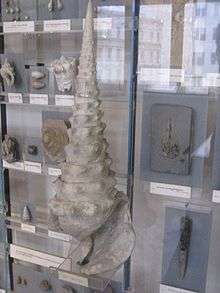
Gastropods (Gastropoda)
Snails and slugs (Gastropoda)
The largest-known of this group were in the genus Campanile, with the extinct Campanile giganteum having shell lengths up to 90 cm (35 in).[128]
Bivalves (Bivalvia)
Bivalves (Bivalvia)
The largest-known bivalve ever was Platyceramus platinus, a giant that usually had an axial length of 1 m (3 ft 3 in), but some individuals could reach an axial length of up to 3 m (9.8 ft).
Cephalopods (Cephalopoda)
Ammonites (Ammonoidea)
The largest-known ammonite was Parapuzosia seppenradensis. A partial fossil specimen found in Germany had a shell diameter of 1.95 m (6 ft 5 in), but the living chamber was incomplete, so the estimated shell diameter was probably about 2.55 m (8 ft 4 in) when it was alive.
Belemnites (Belemnoidea)
The largest-known belemnite was Megateuthis gigantea with a guard of 46 cm (18 in) in length and an estimated total length 3 m (9.8 ft) long.
Nautiloids (Nautiloidea)
The longest- and largest-known of this group was Cameroceras with a shell length of 9 m (30 ft).[129]
Neocoleoidea
Both Tusoteuthis and Yezoteuthis are estimated to be similar in size to the modern-day giant squid.[130]
See also
- Dinosaur size
- Largest organisms
- Megafauna
- Nature timeline
References
- Carbone, Chris; Teacher, Amber; Rowcliffe, J (2007). "The Costs of Carnivory". PLOS Biology. 5 (2): e22. doi:10.1371/journal.pbio.0050022. PMC 1769424. PMID 17227145.
- Hokkanen, J.E.I. (21 February 1986). "The size of the largest land animal". Journal of Theoretical Biology. 118 (4): 491–499. CiteSeerX 10.1.1.63.3969. doi:10.1016/S0022-5193(86)80167-9. PMID 3713220. Department of Theoretical Physics, University of Helsinki.
- Staff. "Zaglossus hacketti – extinct giant echidna". Tourism Western Australia. Archived from the original on 2014-01-26. Retrieved 2014-04-28.
- Ice Age Marsupial Topped Three Tons, Scientists Say, 2003-09-17. Retrieved 2003-09-17.
- Richards, Hazel L.; Wells, Rod T.; Evans, Alistair R.; Fitzgerald, Erich M. G.; Adams, Justin W. (2019-09-13). "The extraordinary osteology and functional morphology of the limbs in Palorchestidae, a family of strange extinct marsupial giants". PLOS ONE. 14 (9): e0221824. doi:10.1371/journal.pone.0221824. ISSN 1932-6203. PMC 6744111. PMID 31518353.
- Wroe, S.; Myers, T. J.; Wells, R. T.; Gillespie, A. (1999). "Estimating the weight of the Pleistocene marsupial lion, Thylacoleo carnifex (Thylacoleonidae:Marsupialia): implications for the ecomorphology of a marsupial super-predator and hypotheses of impoverishment of Australian marsupial carnivore faunas". Australian Journal of Zoology. 47 (5): 489. doi:10.1071/ZO99006. ISSN 0004-959X.
- Helgen, K. M.; Wells, R. T.; Kear, B. P.; Gerdtz, W. R.; Flannery, T. F. (2006). "Ecological and evolutionary significance of sizes of giant extinct kangaroos". Australian Journal of Zoology. 54 (4): 293–303. doi:10.1071/ZO05077.
- Kysely, René. "Aurochs and potential crossbreeding with domestic cattle in Central Europe in the Eneolithic period. A metric analysis of bones from the archaeological site of Kutná Hora-Denemark (Czech Republic)". Anthropozoologica. 43 (2): 2008.
- Giant Camel Disappeared Species Archived 2013-11-10 at the Wayback Machine. Intechinc.com (2011-07-05)
- Mendoza, M.; Janis, C. M.; Palmqvist, P. (2006). "Estimating the body mass of extinct ungulates: a study on the use of multiple regression". Journal of Zoology. 270 (1): 90–101. CiteSeerX 10.1.1.541.9021. doi:10.1111/j.1469-7998.2006.00094.x.
- Teeth: Kubanochoerus gigas lii (GUAN). tesorosnaturales.es
- David Petersen. Of Moose, Megaloceros and Miracles. Motherearthnews.com (1989-03-01)
- Geist, Valerius (1998). Deer of the world: their evolution, behaviour, and ecology. ISBN 9780811704960.Oxworth Books. pp. 111, 126, 247–250. (1998) ISBN 0811704963
- Deméré, Thomas A.; Berta, Annalisa; McGowen, Michael R. (2005). "The taxonomic and evolutionary history of fossil and modern balaenopteroid mysticetes". Journal of Mammalian Evolution. 12 (1/2): 99–143. doi:10.1007/s10914-005-6944-3.
- Larramendi, A. (2016). "Shoulder height, body mass and shape of proboscideans" (PDF). Acta Palaeontologica Polonica. 61. doi:10.4202/app.00136.2014.
- Fortelius, M.; Kappelman, J. (1993). "The largest land mammal ever imagined". Zoological Journal of the Linnean Society. 108: 85–101. doi:10.1111/j.1096-3642.1993.tb02560.x.
- http://www.vera-eisenmann.com/IMG/pdf/136.Gigantic_horses.pdf
- Soibelzon, L. H.; Schubert, B. W. (January 2011). "The Largest Known Bear, Arctotherium angustidens, from the Early Pleistocene Pampean Region of Argentina: With a Discussion of Size and Diet Trends in Bears". Journal of Paleontology. 85 (1): 69–75. doi:10.1666/10-037.1. Retrieved 2011-06-01.
- Dell'Amore, C. (2011): Biggest Bear Ever Found, National Geographic News, Published February 3, 2011
- Alan Turner, National Geographic Prehistoric Mammals National Geographic, 2004, ISBN 0792271343
- Hertler, Christine; Volmer, Rebekka (2008). "Assessing prey competition in fossil carnivore communities — a scenario for prey competition and its evolutionary consequences for tigers in Pleistocene Java". Palaeogeography, Palaeoclimatology, Palaeoecology. 257 (1–2): 67–80. Bibcode:2008PPP...257...67H. doi:10.1016/j.palaeo.2007.09.004.
- Paul S Martin (1984). Quaternary Extinctions. The University of Arizona Press. ISBN 978-0-8165-1100-6.
- Merriam, J. C. & Stock, C. 1932: The Felidae of Rancho La Brea. Carnegie Institution of Washington Publications 442, 1–231.
- DeSantis, L. R.; Schubert, B. W.; Scott, J. R.; Ungar, P. S. (2012). "Implications of diet for the extinction of saber-toothed cats and American lions". PLOS ONE. 7 (12): e52453. Bibcode:2012PLoSO...752453D. doi:10.1371/journal.pone.0052453. PMC 3530457. PMID 23300674.
- Sorkin, B (2008). "A biomechanical constraint on body mass in terrestrial mammalian predators". Lethaia. 41 (4): 333–347. doi:10.1111/j.1502-3931.2007.00091.x.
- Peigné, S.; de Bonis, L.; Likius, A.; Mackaye, H. T.; Vignaud, P.; Brunet, M. (2005). "A new machairodontine (Carnivora, Felidae) from the Late Miocene hominid locality of TM 266, Toros-Menalla, Chad". Comptes Rendus Palevol. 4 (3): 243–253. doi:10.1016/j.crpv.2004.10.002.
- "Wolves, Coyotes, and Dogs (Genus Canis)". Museum.state.il.us. Retrieved 2011-10-23.
- http://www.app.pan.pl/archive/published/app56/app20100005.pdf
- Geraads, Denis; Alemseged, Zeresenay; Bobe, René; Reed, Denné (2011). "Enhydriodon dikikae, sp. nov. (Carnivora: Mammalia), a gigantic otter from the Pliocene of Dikika, Lower Awash, Ethiopia". Journal of Vertebrate Paleontology. 31 (2): 447–453. doi:10.1080/02724634.2011.550356.
- "The Bear Otter". Wired. 2011-03-26.
- "Siamogale melilutra: Giant Otter Fossils Reveal New Species – Paleontology – Sci-News.com". sci-news.com.
- "Islands of otters and strange foxes". scienceblogs.com.
- "SABERTOOTH'S BANE: INTRODUCING DINOCROCUTA". wordpress.com. 12 January 2016.
- Villier, Boris (2010). "Deinogalerix: a giant hedgehog from the Miocene". Annali dell'Università di Ferrara. 6: 93–102. ISSN 1824-2707.
- "BBC – Science & Nature – Wildfacts – Megatherium". 2014-02-01. Archived from the original on 2014-02-01. Retrieved 2017-06-29.CS1 maint: BOT: original-url status unknown (link)
- Ciochon, Russell L. "The Ape that Was – Asian fossils reveal humanity's giant cousin". University of Iowa. Archived from the original on 2015-05-25. Retrieved 2007-12-06.
- Pettifor, Eric (2000) [1995]. "From the Teeth of the Dragon: Gigantopithecus Blacki". Selected Readings in Physical Anthropology. Kendall/Hunt Publishing Company. pp. 143–149. ISBN 978-0-7872-7155-8. Retrieved 2008-01-30.
- Delson, Eric; Terranova, Carl J.; Jungers, William J; Sargis, Sargis; Jablonski, Nina G.; Dechow, Paul C. (2000). "Body mass in Cercopithecidae (Primates, Mammalia): estimation and scaling in extinct and extant taxa". Anthropological Papers of the American Museum of Natural History. 83: 1–159.
- Jablonski, Nina; Leakey, Meave; Anton, Mauricio (2008-01-01), Jablonski, N.G. Leakey, M.G. and Anton, M. (2008) Systematic Paleontology of the Cercopithecines. In: Jablonski, N.G. and Leakey, M.G. (eds.) Koobi Fora Research Project. Volume 6. The Fossil Monkeys. California Academy of Sciences, San Francisco, pp. 103-300., pp. 103–300, retrieved 2020-05-03
- Osborn, H. F. (1942). Proboscidea, Vol. II. New York: The American Museum Press.
- Rinderknecht, Andrés; R. Ernesto Blanco (2008-01-15). "The largest fossil rodent" (PDF). Proceedings of the Royal Society B: Biological Sciences. 275 (1637): 923–8. doi:10.1098/rspb.2007.1645. PMC 2599941. PMID 18198140. Retrieved 2008-01-16. Lay summary.
- Johnson, Steven C. and Madden, Richard H. 1997. Uruguaytheriinae Astrapotheres of Tropical South America. Chapter 22 in "Vertebrate Paleontology in the Neotropics. The Miocene Fauna of La Venta, Colombia". Edited by Richard F. Kay, Richard H. Madden, Richard L. Cifelli, and John J. Flynn. Smithsonian Institution Press. Washington and London.
- Kramarz, Alejandro G.; Bond, Mariano (2008). "Revision of Parastrapotherium (Mammalia, Astrapotheria) and other Deseadan astrapotheres of Patagonia". Ameghiniana. 45 (3). Retrieved March 1, 2013.CS1 maint: ref=harv (link)
- Juan D. Carrillo; Eli Amson; Carlos Jaramillo; Rodolfo Sánchez; Luis Quiroz; Carlos Cuartas; Aldo F. Rincón; Marcelo R. Sánchez-Villagra (2018). "The Neogene record of northern South American native ungulates". Smithsonian Contributions to Paleobiology. 101 (101): iv-67. doi:10.5479/si.1943-6688.101.
- Nicholas D. Pyenson, Geerat J. Vermeij, The rise of ocean giants: maximum body size in Cenozoic marine mammals as an indicator for productivity in the Pacific and Atlantic Oceans, Published 5 July 2016.DOI: 10.1098/rsbl.2016.0186
- Gingerich, Philip D. (1998). "Paleobiological Perspectives on Mesonychia, Archaeoceti, and the Origin of Whales". In Thewissen, J.G.M. (ed.). The emergence of whales: evolutionary patterns in the origin of Cetacea. New York: Plenum Press. pp. 423–450. ISBN 978-0-306-45853-8.
- Elissamburu, A (2012). "Estimación de la masa corporal en géneros del Orden Notoungulata". Estudios Geológicos. 68 (1): 91–111. doi:10.3989/egeol.40336.133.
- Sorkin, B. (2008). "A biomechanical constraint on body mass in terrestrial mammalian predators". Lethaia. 41 (4): 333–347. doi:10.1111/j.1502-3931.2007.00091.x.
- "Permian Stratigraphy - International Commission on Stratigraphy International Union of Geological Sciences" (PDF). Archived (PDF) from the original on 3 December 2018. Retrieved 16 October 2019.
- Reisz, Robert R.; Fröbisch, Jörg (16 April 2014). "The Oldest Caseid Synapsid from the Late Pennsylvanian of Kansas, and the Evolution of Herbivory in Terrestrial Vertebrates". PLOS ONE. 9 (4): e94518. Bibcode:2014PLoSO...994518R. doi:10.1371/journal.pone.0094518. PMC 3989228. PMID 24739998.
- Brink, Kirstin S.; Reisz, Robert R. (16 October 2014). "Hidden dental diversity in the oldest terrestrial apex predator Dimetrodon". Nature Communications. 5: 3269. Bibcode:2014NatCo...5.3269B. doi:10.1038/ncomms4269. PMID 24509889.
- St. Fleur, Nicholas (4 January 2019). "An Elephant-Size Relative of Mammals That Grazed Alongside Dinosaurs". The New York Times. Retrieved 7 January 2019.
- Sulej, Tomasz; Niedzwiedzki, Grzegorz (4 January 2019). "An elephant-sized Late Triassic synapsid with erect limbs". Science. 363 (6422): 78–80. Bibcode:2019Sci...363...78S. doi:10.1126/science.aal4853. PMID 30467179.
- Staff (23 November 2018). "Gigantic mammal 'cousin' discovered". Science Daily. Retrieved 7 January 2019.
- van Valkenburgh, Blaire; Jenkins, Ian (2002). "Evolutionary Patterns in the History of Permo-Triassic and Cenozoic synapsid predators". Paleontological Society Papers 8: 267–288.
- "Brithopodidae / Anteosauridae". Kheper. M.Alan Kazlev. Retrieved 24 October 2015.
- Lyon, Gabrielle. "Fact Sheet". SuperCroc. Project Exploration. Retrieved 2007-09-22.
- Lucas, Spencer G.; Robert M. Sullivan; Justin A. Spielmann (2006). "The Giant Crocodylian Deinosuchus from the Upper Cretaceous of the San Juan Basin, New Mexico" (PDF). New Mexico Museum of Natural History and Science Bulletin. 35. Archived from the original (PDF) on June 17, 2009. Retrieved 11 May 2010.
- Bocquentin, Jean; Melo, Janira (2006). "Stupendemys souzai sp. nov (Pleurodira, Podocnemididae) from the Miocene-Pliocene of the Solimões Formation, Brazil". Revista Brasileira de Paleontologia. 9 (2): 187–192. doi:10.4072/rbp.2006.2.02.
- Head, J. J. (2001). "Systematics and body size of the gigantic, enigmatic crocodyloid Rhamphosuchus crassidens, and the faunal history of Siwalik Group (Miocene) crocodylians". Journal of Vertebrate Paleontology. 21 (Supplement to No. 3): 1–117. doi:10.1080/02724634.2001.10010852.
- Dortangs, Rudi W.; Anne S. Schulp; Eric W. A. Mulder; John W.M. Jagt (2002). "A large new mosasaur from the Upper Cretaceous of The Netherlands". Netherlands Journal of Geosciences. 81 (1): 1–8. doi:10.1017/S0016774600020515.
- Everhart, Mike. "Research: Tylosaurus proriger – A new record of a large mosasaur from the Smoky Hill Chalk". Retrieved 12 May 2010.
- "Fact File: Tylosaurus Proriger from National Geographic". Retrieved 12 May 2010.
- Russell, D. A. 1967. Systematics and morphology of American mosasaurs (Reptilia, Sauria). Yale Univ. Bull 23:241. pp.
- Lingham-Soliar, T (1998). "Unusual death of a Cretaceous giant". Lethaia. 31 (4): 308–310. doi:10.1111/j.1502-3931.1998.tb00520.x.
- Lindgren, Johan (2005). "The first record of Hainosaurus (Reptilia: Mosasauridae) from Sweden". Journal of Paleontology. 79 (6): 1157–1165. doi:10.1666/0022-3360(2005)079[1157:tfrohr]2.0.co;2.
- Head, Jason J.; et al. (5 February 2009). "Giant boid snake from the Palaeocene neotropics reveals hotter past equatorial temperatures" (PDF). Nature. 457 (7230): 715–717. Bibcode:2009Natur.457..715H. doi:10.1038/nature07671. PMID 19194448. Retrieved 12 May 2010.
- Head, J. & Polly, D. 2004. They might be giants: morphometric methods for reconstructing body size in the world’s largest snakes. Journal of Vertebrate Paleontology 24 (Supp. 3), 68A-69A.
- "A giant among snakes". newscientist.com.
- Rage, Jean-Claude; Sunil Bajpai; Johannes G. M. Thewissen; Brahma N. Tiwari (2003). "Early Eocene snakes from Kutch, Western India, with a review of the Palaeophiidae" (PDF). Geodiversitas. 25 (4): 695–716. ISSN 1280-9659. Retrieved 12 May 2010.
- Rage, J.-C. (1983). "Palaeophis colossaeus nov. sp. (le plus grand Seprent connu?) de l'Eocène du Mali et le problème du genre chez les Palaeopheinae". Comptes Rendus des Séances de l'Académie des Sciences. 3 (296): 1741–1744.
- Molnar, Ralph E. (2004). Dragons in the dust: the paleobiology of the giant monitor lizard Megalania. Bloomington: Indiana University Press. ISBN 978-0-253-34374-1.
- "Review of DRAGONS IN THE DUST: THE PALEOBIOLOGY OF THE GIANT MONITOR LIZARD MEGALANIA, by Ralph E. Molnar, 2004 in the Journal of Vertebrate Paleontology 25(2):479, June 2005" (PDF). Retrieved 12 January 2012.
- Alleyne, Richard (2009-03-17). "Biggest and smallest prehistoric predators unearthed". The Daily Telegraph. London. Retrieved 2009-03-17.
- Coghlan, Andy (2009-03-17). "Fossil of 'ultimate predator' unearthed in Arctic". New Scientist. Retrieved 2009-03-17.
- Buchy, M.-C.; Frey, E.; Stinnesbeck, W.; López-Oliva, J.G. (2003). "First occurrence of a gigantic pliosaurid plesiosaur in the late Jurassic (Kimmeridgian) of Mexico". Bulletin de la Société Géologique de France. 174 (3): 271–278. doi:10.2113/174.3.271. hdl:2042/260.
- "Monster von Arramberri". Retrieved 6 February 2010.
- "The Cumnor monster mandible". Archived from the original on 11 October 2011. Retrieved 31 October 2011.
- "Triassic Giant". Retrieved 7 February 2010.
- "Researchers have found a 205-million-year-old jawbone from one of the largest animals that ever lived". 2018-04-09.
- Afro-American River Turtles: Podocnemididae – Behavior And Reproduction. animals.jrank.org
- Lutz, Peter L.; John A. Musick (1996). The Biology of Sea Turtles. CRC Press. p. 432pp. ISBN 978-0-8493-8422-6.
- Wood, R. C. (1976). Stupendemys geographicus, the world's largest turtle. 436. Brevoira. pp. 1–31.
- Researchers reveal ancient giant turtle fossil. Phys.org (2012-05-17)
- Maugh II, Thomas H. (2012-05-18). "Researchers find fossil of a turtle that was size of a Smart car". LA Times.
- Freeman, David (2012-05-17). "Car-Sized Reptile Lived Alongside Titanoboa, Scientists Say". Huffington Post.
- Jr, George R. McGhee (7 August 2018). Carboniferous Giants and Mass Extinction: The Late Paleozoic Ice Age World. Columbia University Press. ISBN 9780231543385. Retrieved 16 October 2019 – via Google Books.
- Piñeiro, Graciela; Núñez Demarco, Pablo; Meneghel, Melitta D. (17 May 2016). "The ontogenetic transformation of the mesosaurid tarsus: a contribution to the origin of the primitive amniotic astragalus". PeerJ. 4: e2036. doi:10.7717/peerj.2036. PMC 4878385. PMID 27231658.
- Buffetaut, E.; Grigorescu, D.; Csiki, Z. (2002). "A new giant pterosaur with a robust skull from the latest Cretaceous of Romania". Naturwissenschaften. 89 (4): 180–184. Bibcode:2002NW.....89..180B. doi:10.1007/s00114-002-0307-1. PMID 12061403.
- Carpenter, K. (2006). "Biggest of the big: a critical re-evaluation of the mega-sauropod Amphicoelias fragillimus". In Foster, J. R. and Lucas, S. G., eds., 2006, Paleontology and Geology of the Upper Jurassic Morrison Formation. New Mexico Museum of Natural History and Science Bulletin 36: 131–138.
- "Maraapunisaurus fragillimus, N.G. (formerly Amphicoelias fragillimus), a basal Rebbachisaurid from the Morrison Formation (Upper Jurassic) of Colorado". Geology of the Intermountain West. 5 (9). 2018-10-19. ISSN 2380-7601. Archived from the original on 2018-10-22. Retrieved 2018-11-16.
- "How horrifying was the neck of Barosaurus?". svpow.com. 16 September 2016.
- Paul, G.S., 2010, The Princeton Field Guide to Dinosaurs, Princeton University Press.
- "Giant dinosaur slims down... a bit". BBC News. 2017-08-10. Retrieved 2018-11-18.
- "Don't believe the hype: Patagotitan was not bigger than Argentinosaurus". Sauropod Vertebra Picture of the Week. 2017-08-09. Retrieved 2018-11-18.
- "Just write the Archbishop description already!". svpow.com. 3 September 2015.
- Nima. "Is the French Monster a Euhelopodid?". paleoking.blogspot.com.
- Thompson, Helen. "Meet the Mighty Spinosaurus, the First Dinosaur Adapted for Swimming". Smithsonian. Retrieved 2017-11-22.
- Therrien, F.; Henderson, D.M. (2007). "My theropod is bigger than yours...or not: estimating body size from skull length in theropods". Journal of Vertebrate Paleontology. 27 (1): 108–115. doi:10.1671/0272-4634(2007)27[108:MTIBTY]2.0.CO;2. ISSN 0272-4634.
- dal Sasso, C.; Maganuco, S.; Buffetaut, E.; Mendez, M.A. (2005). "New information on the skull of the enigmatic theropod Spinosaurus, with remarks on its sizes and affinities". Journal of Vertebrate Paleontology. 25 (4): 888–896. doi:10.1671/0272-4634(2005)025[0888:NIOTSO]2.0.CO;2.
- Calvo, Jorge O.; Coria, Rodolfo (1998). "New specimen of Giganotosaurus Carolinii" (PDF). GAIA: 117–122. Archived from the original (PDF) on 2008-02-16.
- Henderson DM (January 1, 1999). "Estimating the masses and centers of mass of extinct animals by 3-D mathematical slicing". Paleobiology. 25 (1): 88–106.
- Vickaryous, M.K., Maryanska, T., & Weishampel, D.B. 2004. Ankylosauria. In: Weishampel, D.B., Dodson, P., & Osmólska, H. (Eds.). The Dinosauria (2nd edition). Berkeley: University of California Press. Pp. 363-392.
- Coombs, Walter P. (December 1978). "Theoretical Aspects of Cursorial Adaptations in Dinosaurs". The Quarterly Review of Biology. 53 (4): 393–418. doi:10.1086/410790.
- Holtz, Thomas R. Jr. (2008). Dinosaurs: The Most Complete, Up-to-Date Encyclopedia for Dinosaur Lovers of All Ages (PDF). New York: Random House. pp. updated appendix. ISBN 978-0-375-82419-7.
- Zhao, X.; Li, D.; Han, G.; Hao, H.; Liu, F.; Li, L.; Fang, X. (2007). "Zhuchengosaurus maximus from Shandong Province". Acta Geoscientia Sinica. 28 (2): 111–122. doi:10.1007/s10114-005-0808-x.
- Morris, William J. (1981). "A new species of hadrosaurian dinosaur from the Upper Cretaceous of Baja California: ?Lambeosaurus laticaudus". Journal of Paleontology. 55 (2): 453–462.
- "Dromornis stirtoni". Australian Museum.
- "Giant bird found on hobbit island". 7 December 2010 – via news.bbc.co.uk.
- Meijer HJ, R ADue (2010). "A new species of giant marabou stork (Aves: Ciconiiformes) from the Pleistocene of Liang Bua, Flores (Indonesia)". Zoological Journal of the Linnean Society. 160 (4): 707–724. doi:10.1111/j.1096-3642.2010.00616.x.
- Alvarenga, Herculano M.F.; Höfling, Elizabeth (2003). "Systematic revision of the Phorusrhacidae (Aves: Ralliformes)". Papéis Avulsos de Zoologia. 43 (4). doi:10.1590/S0031-10492003000400001.
- California Academy of Sciences – Science Under Sail Archived 2012-06-07 at the Wayback Machine. Calacademy.org
- Arredondo, Oscar (1976) translated Olson, Storrs L. The Great Predatory Birds of the Pleistocene of Cuba pp. 169-187 in "Smithsonian Contributions to Paleobiology number 27; Collected Papers in Avian Paleontology Honoring the 90th Birthday of Alexander Wetmore"
- Evidence of a giant helmeted frog (Australobatrachia, Calyptocephalellidae) from Eocene levels of the Magallanes Basin, southernmost Chile
- Palmer, D., ed. (1999). The Marshall Illustrated Encyclopedia of Dinosaurs and Prehistoric Animals. London: Marshall Editions. p. 53. ISBN 978-1-84028-152-1.
- Levy, D.L., & Heald, R. (2015). "Biological Scaling Problems and Solutions in Amphibians." Cold Spring Harbor Perspectives in Biology, a019166.
- Liston, J., Newbrey, M., Challands, T., and Adams, C., 2013, "Growth, age and size of the Jurassic pachycormid Leedsichthys problematicus (Osteichthyes: Actinopterygii) in: Arratia, G., Schultze, H. and Wilson, M. (eds.) Mesozoic Fishes 5 – Global Diversity and Evolution. Verlag Dr. Friedrich Pfeil, München, Germany, pp. 145-175
- deGruy, Michael (2006). Perfect Shark (TV-Series). BBC (UK).
- Klimley, Peter; Ainley, David (1996). Great White Sharks: The Biology of Carcharodon carcharias. Academic Press. ISBN 978-0-12-415031-7.
- Pimiento C, Ehret DJ, Macfadden BJ, Hubbell G (2010). "Ancient nursery area for the extinct giant shark megalodon from the Miocene of Panama". PLOS ONE. 5 (5): e10552. Bibcode:2010PLoSO...510552P. doi:10.1371/journal.pone.0010552. PMC 2866656. PMID 20479893.
- Wroe, S.; Huber, D. R.; Lowry, M.; McHenry, C.; Moreno, K.; Clausen, P.; Ferrara, T. L.; Cunningham, E.; Dean, M. N.; Summers, A. P. (2008). "Three-dimensional computer analysis of white shark jaw mechanics: how hard can a great white bite?". Journal of Zoology. 276 (4): 336–342. doi:10.1111/j.1469-7998.2008.00494.x.
- "Buzzsaw-toothed leviathans cruised the ancient seas". eartharchives.org.
- http://img06.deviantart.net/8207/i/2015/143/8/e/parahelicoprion_clerci_by_teratophoneus-d8uf4rh.png
- Editorial, Reuters (2015-03-11). "Gigantic ancient arthropod was really 'a very peaceful guy'". Reuters.
- Gutiérrez-Marco, Juan C.; Sá, Artur A.; Garcia-Bellido, Diego C.; Rabano, Isabel; Valério, Manuel (2009). "Giant Trilobites and Trilobite Clusters from the Ordovician of Portugal". Geology. 37 (5): 443–446. Bibcode:2009Geo....37..443G. doi:10.1130/G25513A.1.
- Schaal, Stephan (27 January 2006). Messel. eLS. doi:10.1038/npg.els.0004143. ISBN 978-0470016176.
- Peters, K. E.; Peters, Kenneth Eric; Walters, C. C.; Moldowan, J. M. (2005). The Biomarker Guide: Biomarkers and Isotopes in Petroleum Systems and Earth History. p. 1107. ISBN 9780521837620.
- http://www.e-periodica.ch/cntmng?pid=egh-001:1987:80::1248
- Teichert C; B Kummel (1960). "Size of Endocerid Cephalopods". Breviora Mus. Comp. Zool. 128: 1–7.
- "Tusoteuthis and Cretaceous Giant Squid".
